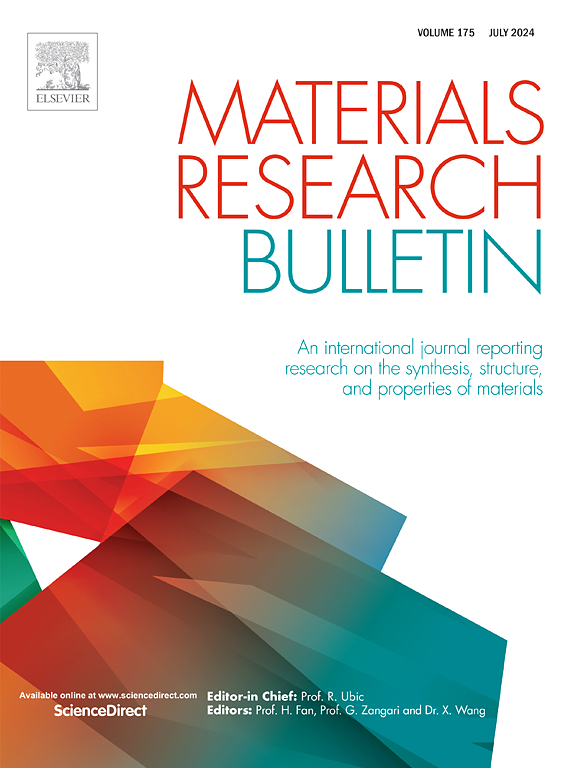WO3/Ti3C2Tx MXene复合材料作为锂离子电池负极的静电自组装
IF 5.7
3区 材料科学
Q2 MATERIALS SCIENCE, MULTIDISCIPLINARY
引用次数: 0
摘要
商用石墨电极在锂离子电池(LIBs)中表现出有限的理论容量,需要探索和开发具有卓越倍率性能、可逆比容量和延长循环寿命的创新阳极材料。研究发现,MXene具有金属导电性和独特的二维层状结构,在电化学储能领域引起了极大的兴趣和关注。三氧化钨(WO3)是一种低成本的n型半导体材料。作为锂离子电池的负极材料,其产生的活性位点可以提高电池的电化学性能。本研究采用高效的静电自组装技术合成了WO3/MXene杂化物。这种复合材料结合了WO3和MXene的优点,促进了界面上电子和离子的快速传递,同时有效地减轻了循环过程中的结构变化。作为锂离子存储的负极材料,WO3/MXene复合材料表现出增强的可逆容量和优异的循环稳定性。在100 mA g-1下循环100次后,其可逆比容量为318.5 mA h g-1,在200 mA g-1下循环400次后,比容量从191.8 mA h g-1增加到302.9 mA h g-1。通过扫描电镜(SEM)、x射线光电子能谱(XPS)、循环伏安法(CV)和电化学阻抗谱(EIS)等一系列测试阐明了WO3/MXene复合材料的增强机理,得出WO3/MXene复合材料作为锂离子电池负极材料的候选材料很有前途。本文章由计算机程序翻译,如有差异,请以英文原文为准。

Electrostatic self-assembly of WO3/Ti3C2Tx MXene composite as anode for lithium-ion batteries
The limited theoretical capacity exhibited by commercial graphite electrodes in lithium-ion batteries (LIBs) necessitates the exploration and development of innovative anode materials that possess superior rate performance, reversible specific capacity, and extended cycle life. Research has found that MXene exhibits metallic conductivity and a unique two-dimensional layered structure, which has attracted great interest and attention in electrochemical energy storage. Tungsten trioxide (WO3) is a low-cost n-type semiconductor material. When utilized as the anode material in lithium-ion batteries, the active sites generated by it can enhance the electrochemical properties of the batteries. In this study, WO3/MXene hybrids were synthesized using an efficient electrostatic self-assembly technique. This composite material combines the advantages of both WO3 and MXene, facilitating rapid electron and ion transport at the interface while effectively mitigating structural alterations during the cycling process. When utilized as the anode material for lithium-ion storage, the WO3/MXene composite demonstrates enhanced reversible capacity and exceptional cycling stability. It demonstrates a reversible specific capacity of 318.5 mA h g-1 after 100 cycles at 100 mA g-1 and experiences an increase in specific capacity from 191.8 mA h g-1 to 302.9 mA h g-1 after 400 cycles at 200 mA g-1. After elucidating the enhancement mechanism through a range of tests, including scanning electron microscopy (SEM), X-ray photoelectron spectroscopy (XPS), cyclic voltammetry (CV), and electrochemical impedance spectroscopy (EIS), we conclude that the WO3/MXene composite is a promising candidate as an anode material for lithium-ion batteries.
求助全文
通过发布文献求助,成功后即可免费获取论文全文。
去求助
来源期刊

Materials Research Bulletin
工程技术-材料科学:综合
CiteScore
9.80
自引率
5.60%
发文量
372
审稿时长
42 days
期刊介绍:
Materials Research Bulletin is an international journal reporting high-impact research on processing-structure-property relationships in functional materials and nanomaterials with interesting electronic, magnetic, optical, thermal, mechanical or catalytic properties. Papers purely on thermodynamics or theoretical calculations (e.g., density functional theory) do not fall within the scope of the journal unless they also demonstrate a clear link to physical properties. Topics covered include functional materials (e.g., dielectrics, pyroelectrics, piezoelectrics, ferroelectrics, relaxors, thermoelectrics, etc.); electrochemistry and solid-state ionics (e.g., photovoltaics, batteries, sensors, and fuel cells); nanomaterials, graphene, and nanocomposites; luminescence and photocatalysis; crystal-structure and defect-structure analysis; novel electronics; non-crystalline solids; flexible electronics; protein-material interactions; and polymeric ion-exchange membranes.
 求助内容:
求助内容: 应助结果提醒方式:
应助结果提醒方式:


